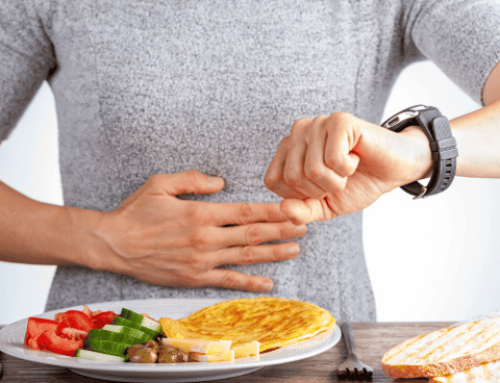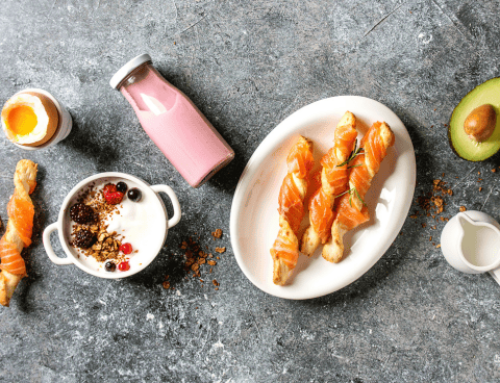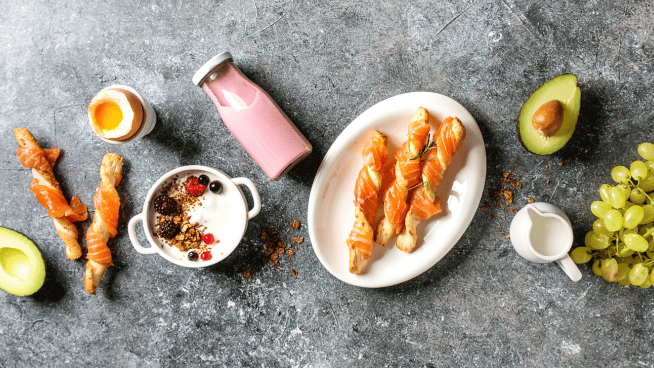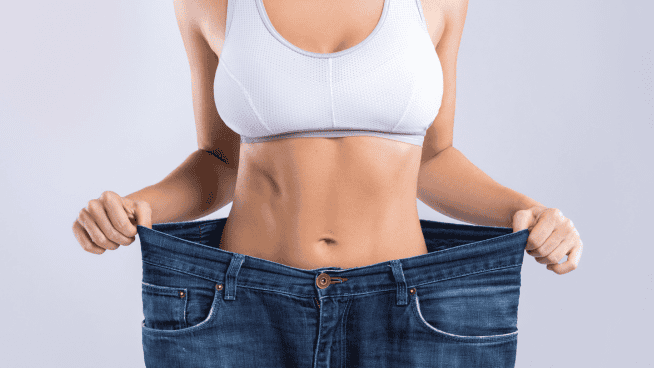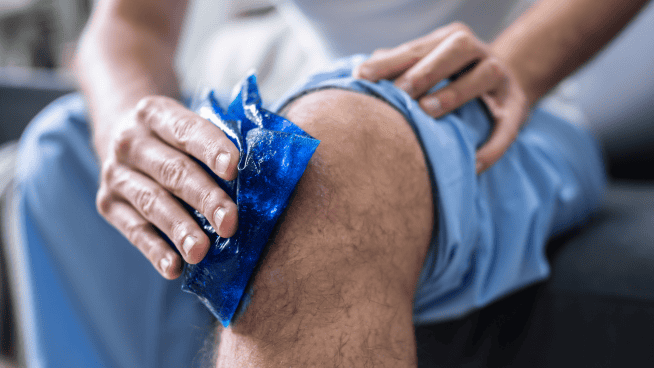3 Important Ways to Turn Your Body Into a Fat-Burning Machine
Imagine attending a holiday party surrounded by tempting high-calorie appetizers, beverages and desserts—while watching a quarterback on TV scrambling to avoid attacking linebackers.
Like the quarterback feeling pressure and getting sacked, athletes and non-athletes may find it hard to avoid irresistible party fare and getting sacked with unwanted post-holiday pounds and additional body fat.
This article provides a fat-burning game plan.
Fat-Blasting Workout Tips
Boost metabolism with higher intensity workouts. Doug McGuff, M.D. and John Little, authors of Body by Science (2009, McGraw-Hill), say that “high-intensity exercise is invaluable in the fat-loss process by helping to control insulin levels in the body. . . In addition, high-intensity exercise burns a respectable amount of calories during a workout and continues to burn calories, at an elevated rate, for hours afterward.”
Examples of high intensity workouts for building lean muscle, burning more fat and expending calories:
- Switch from doing seated or supine exercises to performing more multi-joint standing movements, which optimally require more energy and engage the core muscles. We are talking Deadlifts, Barbell Squats, Step-Ups, Bent-Over Rows, Upright Rows and Lunges.
- Incorporate more challenging single-leg exercises (Single-Leg Squats, Single-Leg Dumbbell Cross-Rows, Planks with one foot off the floor), which also more actively stimulate core muscles. Bonus: Single-leg movements improve balance for sports and daily activities.
- “No huddle” fat-loss offense: Take shorter rests between sets or perform supersets to enhance training and raise metabolism (which also make workouts more time-efficient, productive and good for sports endurance).
- Perform more full-body exercises that simultaneously involve the lower and upper body—Squat and Overhead Press combo, Power Cleans, Upright Row and Lunge combo, Side Lunge and Med Ball Press-Out combo.
- Do isometric hold reps. On the last rep of each exercise, hold for several seconds—e.g., pull yourself up to the top position of Inverted Rows and tense your biceps while you hold for 10 or more seconds; or lower into the bottom position of Wall Squats and feel your leg muscles shake while you hold for several seconds).
- Explosive reps. E.g., instead of doing regular Push-Ups or Bodyweight Squats, raise your metabolism further by performing explosive Push-Ups, Jump Squats, Squat Thrusts and Burpees.
- Negative reps. Change the standard rep tempo by implementing negative reps (e.g., take 10-15 seconds to slowly descend into a squat position; slowly lower in 15 seconds from the top position of a Pull-Up.
Keep the Fat-Burning Clock Running Outside the Weight Room
Chill Out Exercising Outdoors. If the weight room is inaccessible during the holidays, here’s your option play: Head to a park or field and get double fat-blasting benefits by working out outside in the great outdoors—especially in colder conditions and in sunlight. Sunlight provides testosterone muscle-building and fat-burning vitamin D. A University of Minnesota study indicated that vitamin D helps fat loss throughout the body, especially around the waistline (belly fat). The vitamin works with calcium to lower the production of the stress hormone cortisol, which contributes to storing fat around the stomach. The study also showed that higher baseline vitamin D levels predicted greater loss of abdominal fat.
Regarding exercising in cold weather and burning fat, Takeshi Yoneshiro, a researcher at Japan’s Hokkaido University Graduate School of Medicine, says that exposure to cold seems to increase the number and activity of so-called “brown” fat cells, which burn energy rather than store it as typical “white” fat cells do.
Experience a terrific bodyweight-only outdoor workout by sprinting up and down stadium bleachers or steep hills; doing several sets of Pull-Ups on playground bars; or performing elevated Push-Ups off park benches or bleachers.
- Sleep away fat. Getting the recommended 8 to 9 hours of quality sleep each night not only aids recovery from sports practices and workouts, but also promotes fat loss by preserving lean muscle. According to journal Annals of Internal Medicine, researchers compared a group that averaged 8.5 hours of nightly sleep with another group that averaged 5.5 hours nightly. “After two weeks, the people who slept more lost more fat than the group who slept less. . . the folks who slept less lost more muscle. Those three hours of lost sleep caused a shift in metabolism that made the body want to preserve fat at the expense of muscle.”
- Walk it off. A multi-course holiday meal can take hours to digest and thereby retard fat-burning metabolism. Clutch play: Stand up between courses and walk around instead of sitting for long periods. After the last course, continue walking to elevate your metabolism.
The Nutritional Fat-Burning Route
Avoid holiday punch and soda and sip cold water instead. Besides its key hydrating role, water—especially cold water—is a powerful fat-melter. Ellington Darden, Ph.D., author of The Body Fat Breakthrough, says “When you drink chilled water (about 40 degrees F), your system has to heat the fluid to a core body temperature of 98.6 degrees F. This process requires almost 1 calorie to warm each ounce of cold water to body temperature.” Darden recommends consuming a gallon of ice-cold water daily for hydration and fat-burning. Consuming cold water throughout the day also helps keep you fuller so you’re less likely to overeat.
Don’t skip breakfast! Your body’s in a fasting state overnight, and the best way to rev up your fat-blasting metabolism for the day ahead is to start with a nutrient-dense breakfast—e.g., a few glasses of cold water, fruit, eggs, milk or yogurt, and whole grain cereal.
Don’t “save your appetite” for the big holiday meal! Starving yourself for hours before the holiday meal is like being stopped at the line of scrimmage for no gain. Your body’s fat-burning metabolism and optimal blood sugar level—for maintaining mental and physical energy, recovering from sports and exercise, and building muscle/losing fat—are contingent on the consumption of small and frequent nutritious meals (comprising protein and carbohydrates such as nuts and fruit) and beverages (cold water) every 2-3 hours throughout the day. Saving your appetite for several hours and skipping meals means you’ll be more likely to overeat later in the day.
Heed what registered dietitian Susan M. Kleiner, Ph.D., RD, author of Powerfood Nutrition Plan (2005, Rodale, Inc.), says: “The successful athletes I’ve worked with never go anywhere without taking some food along with them. These athletes pay attention to what they eat and when they eat, and they never risk missing a meal. That meal, they know, may be the one that makes the difference between recovering adequately between workouts or not recovering at all.”
Portion control. Fill your plate with small portions rather than mounds of meat, potatoes or pasta. And take your time eating by thoroughly chewing your food. Rest 5 or 10 minutes; then, if you want seconds, opt for water-based and less-caloric veggies or fruit with a few slices of lean meat, fish or poultry, for example.
References:
- Doug McGuff, M.D. and John Little. Body by Science. 2009, McGraw-Hill. pp. 195-196.
- Science Daily. June 12, 2009. “Successful Weight Loss With Dieting Is Linked To Vitamin D Levels.”
- Journal of Clinical Investigation. August 1, 2013. “Recruited Brown Adipose Tissue As An Antiobesity Agent In Humans.”
- Annals of Internal Medicine. October 1, 2010. “Insufficient Sleep Undermines Dietary Efforts to Reduce Adiposity.”
- Ellington Darden, PhD. The Body Fat Breakthrough.” 2014, Rodale Inc. pp. 189, 191.
- Susan M. Kleiner, PhD, R.D. Powerfood Nutrition Plan. 2005, Rodale Inc. p. 187.
RECOMMENDED FOR YOU
MOST POPULAR
3 Important Ways to Turn Your Body Into a Fat-Burning Machine
Imagine attending a holiday party surrounded by tempting high-calorie appetizers, beverages and desserts—while watching a quarterback on TV scrambling to avoid attacking linebackers.
Like the quarterback feeling pressure and getting sacked, athletes and non-athletes may find it hard to avoid irresistible party fare and getting sacked with unwanted post-holiday pounds and additional body fat.
This article provides a fat-burning game plan.
Fat-Blasting Workout Tips
Boost metabolism with higher intensity workouts. Doug McGuff, M.D. and John Little, authors of Body by Science (2009, McGraw-Hill), say that “high-intensity exercise is invaluable in the fat-loss process by helping to control insulin levels in the body. . . In addition, high-intensity exercise burns a respectable amount of calories during a workout and continues to burn calories, at an elevated rate, for hours afterward.”
Examples of high intensity workouts for building lean muscle, burning more fat and expending calories:
- Switch from doing seated or supine exercises to performing more multi-joint standing movements, which optimally require more energy and engage the core muscles. We are talking Deadlifts, Barbell Squats, Step-Ups, Bent-Over Rows, Upright Rows and Lunges.
- Incorporate more challenging single-leg exercises (Single-Leg Squats, Single-Leg Dumbbell Cross-Rows, Planks with one foot off the floor), which also more actively stimulate core muscles. Bonus: Single-leg movements improve balance for sports and daily activities.
- “No huddle” fat-loss offense: Take shorter rests between sets or perform supersets to enhance training and raise metabolism (which also make workouts more time-efficient, productive and good for sports endurance).
- Perform more full-body exercises that simultaneously involve the lower and upper body—Squat and Overhead Press combo, Power Cleans, Upright Row and Lunge combo, Side Lunge and Med Ball Press-Out combo.
- Do isometric hold reps. On the last rep of each exercise, hold for several seconds—e.g., pull yourself up to the top position of Inverted Rows and tense your biceps while you hold for 10 or more seconds; or lower into the bottom position of Wall Squats and feel your leg muscles shake while you hold for several seconds).
- Explosive reps. E.g., instead of doing regular Push-Ups or Bodyweight Squats, raise your metabolism further by performing explosive Push-Ups, Jump Squats, Squat Thrusts and Burpees.
- Negative reps. Change the standard rep tempo by implementing negative reps (e.g., take 10-15 seconds to slowly descend into a squat position; slowly lower in 15 seconds from the top position of a Pull-Up.
Keep the Fat-Burning Clock Running Outside the Weight Room
Chill Out Exercising Outdoors. If the weight room is inaccessible during the holidays, here’s your option play: Head to a park or field and get double fat-blasting benefits by working out outside in the great outdoors—especially in colder conditions and in sunlight. Sunlight provides testosterone muscle-building and fat-burning vitamin D. A University of Minnesota study indicated that vitamin D helps fat loss throughout the body, especially around the waistline (belly fat). The vitamin works with calcium to lower the production of the stress hormone cortisol, which contributes to storing fat around the stomach. The study also showed that higher baseline vitamin D levels predicted greater loss of abdominal fat.
Regarding exercising in cold weather and burning fat, Takeshi Yoneshiro, a researcher at Japan’s Hokkaido University Graduate School of Medicine, says that exposure to cold seems to increase the number and activity of so-called “brown” fat cells, which burn energy rather than store it as typical “white” fat cells do.
Experience a terrific bodyweight-only outdoor workout by sprinting up and down stadium bleachers or steep hills; doing several sets of Pull-Ups on playground bars; or performing elevated Push-Ups off park benches or bleachers.
- Sleep away fat. Getting the recommended 8 to 9 hours of quality sleep each night not only aids recovery from sports practices and workouts, but also promotes fat loss by preserving lean muscle. According to journal Annals of Internal Medicine, researchers compared a group that averaged 8.5 hours of nightly sleep with another group that averaged 5.5 hours nightly. “After two weeks, the people who slept more lost more fat than the group who slept less. . . the folks who slept less lost more muscle. Those three hours of lost sleep caused a shift in metabolism that made the body want to preserve fat at the expense of muscle.”
- Walk it off. A multi-course holiday meal can take hours to digest and thereby retard fat-burning metabolism. Clutch play: Stand up between courses and walk around instead of sitting for long periods. After the last course, continue walking to elevate your metabolism.
The Nutritional Fat-Burning Route
Avoid holiday punch and soda and sip cold water instead. Besides its key hydrating role, water—especially cold water—is a powerful fat-melter. Ellington Darden, Ph.D., author of The Body Fat Breakthrough, says “When you drink chilled water (about 40 degrees F), your system has to heat the fluid to a core body temperature of 98.6 degrees F. This process requires almost 1 calorie to warm each ounce of cold water to body temperature.” Darden recommends consuming a gallon of ice-cold water daily for hydration and fat-burning. Consuming cold water throughout the day also helps keep you fuller so you’re less likely to overeat.
Don’t skip breakfast! Your body’s in a fasting state overnight, and the best way to rev up your fat-blasting metabolism for the day ahead is to start with a nutrient-dense breakfast—e.g., a few glasses of cold water, fruit, eggs, milk or yogurt, and whole grain cereal.
Don’t “save your appetite” for the big holiday meal! Starving yourself for hours before the holiday meal is like being stopped at the line of scrimmage for no gain. Your body’s fat-burning metabolism and optimal blood sugar level—for maintaining mental and physical energy, recovering from sports and exercise, and building muscle/losing fat—are contingent on the consumption of small and frequent nutritious meals (comprising protein and carbohydrates such as nuts and fruit) and beverages (cold water) every 2-3 hours throughout the day. Saving your appetite for several hours and skipping meals means you’ll be more likely to overeat later in the day.
Heed what registered dietitian Susan M. Kleiner, Ph.D., RD, author of Powerfood Nutrition Plan (2005, Rodale, Inc.), says: “The successful athletes I’ve worked with never go anywhere without taking some food along with them. These athletes pay attention to what they eat and when they eat, and they never risk missing a meal. That meal, they know, may be the one that makes the difference between recovering adequately between workouts or not recovering at all.”
Portion control. Fill your plate with small portions rather than mounds of meat, potatoes or pasta. And take your time eating by thoroughly chewing your food. Rest 5 or 10 minutes; then, if you want seconds, opt for water-based and less-caloric veggies or fruit with a few slices of lean meat, fish or poultry, for example.
References:
- Doug McGuff, M.D. and John Little. Body by Science. 2009, McGraw-Hill. pp. 195-196.
- Science Daily. June 12, 2009. “Successful Weight Loss With Dieting Is Linked To Vitamin D Levels.”
- Journal of Clinical Investigation. August 1, 2013. “Recruited Brown Adipose Tissue As An Antiobesity Agent In Humans.”
- Annals of Internal Medicine. October 1, 2010. “Insufficient Sleep Undermines Dietary Efforts to Reduce Adiposity.”
- Ellington Darden, PhD. The Body Fat Breakthrough.” 2014, Rodale Inc. pp. 189, 191.
- Susan M. Kleiner, PhD, R.D. Powerfood Nutrition Plan. 2005, Rodale Inc. p. 187.


